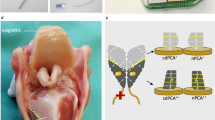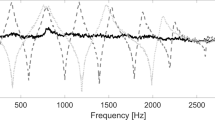Abstract
The pitch of voice is closely related to the vocal fold tension, which is the end result of coordinated movement of the intralaryngeal muscles, and especially the thyroarytenoid muscle. It is known that vocal quality may be affected by surrounding temperature; however, the effect of temperature on vocal fold tension is mostly unknown. Thus, the aim of this study was to evaluate the effect of temperature on isolated rat glottis and thyroarytenoid muscle contraction induced by electrical field stimulation. In vitro isometric tension of the glottis ring from 30 Sprague–Dawley rats was continuously recorded by the tissue bath method. Electrical field stimulation was applied to the glottis ring with two wire electrodes placed parallel to the glottis and connected to a direct-current stimulator. The tension changes of the rat glottis rings that were either untreated or treated with electrical field stimulation were recorded continuously at temperatures from 37 to 7 °C or from 7 to 37 °C. Warming from 7 to 37 °C increased the basal tension of the glottis rings and decreased the electrical field stimulation-induced glottis ring contraction, which was chiefly due to thyroarytenoid muscle contraction. In comparison, cooling from 37 to 7 °C decreased the basal tension and enhanced glottis ring contraction by electrical field stimulation. We concluded that warming increased the basal tension of the glottis in vitro and decreased the amplitude of electrical field stimulation-induced thyroarytenoid muscle contraction. Thus, vocal pitch and the fine tuning of vocal fold tension might be affected by temperature in vivo.





Similar content being viewed by others
References
Alipour F, Ingo R, Titze IR, Hunter E, Tayama N (2005) Active and passive properties of canine abduction/adduction laryngeal muscles. J Voice 19:350–359
Hirano M, Ohala J, Vennard W (1969) The function of laryngeal muscles in regulating fundamental frequency and intensity of phonation. J Speech Hear Res 12:616–628
Yanagi E, Slavit DH, McCaffrey TV (1991) Study of phonation in the excised canine larynx. Otolaryngol Head Neck Surg 105:586–595
Hillel AD (2001) The study of laryngeal muscle activity in normal human subjects and in patients with laryngeal dystonia using multiple fine-wire electromyography. Laryngoscope 111(Suppl 97):1–47
Titze IR, Luschei ES, Hirano M (1989) Role of the thyroarytenoid muscle in regulation of fundamental frequency. J Voice 3:213–224
Jackson RT (1980) An in vitro technique for testing nasal vasodilating agents. Otolaryngol Head Neck Surg 88:434–438
Wang H-W, Wu C-C (2008) Effects of oxymetazoline on isolated rat’s tracheal smooth muscle. Eur Arch Otorhinolaryngol 265:695–698
Alipour-Haghighi F, Titze IR, Perlman AL (1989) Tetanic contraction in vocal fold muscle. J Speech Hear Res 32:226–231
Johns MM, Urbanchek M, Chepeha DB, Kuzon WM Jr, Hogikyan ND (2004) Length-tension relationship of the feline thyroarytenoid muscle. J Voice 18:285–291
Hast MH (1966) Physiological mechanisms of phonation: tension of the vocal fold muscle. Acta Otolaryngol 62:309–318
Chu YH, Wu CC, Kao CH, Wang HW (2006) Low temperature decreased tension in isolated hypertrophic human nasal mucosa. Am J Rhinol 20:84–86
Mustafa S, Thulesius O (2001) Cooling is a potent vasodilator of deep vessels in the rat. Can J Physiol Pharmacol 79:899–904
Herrera B, Desco MM, Eisenberg G, García-Barreno P, Del Cañizo JF (2002) Role of elastic fibers in cooling-induced relaxation. Cryobiology 44:54–61
Li B, Alonso DO, Daggett V (2001) The molecular basis for the inverse temperature transition of elastin. J Mol Biol 305:581–592
Urry DW, Parker TM (2002) Mechanics of elastin: molecular mechanism of biological elasticity and its relationship to contraction. J Muscle Res Cell Motil 23:543–559
Hahn MS, Kobler JB, Starcher BC, Zeitels SM, Langer R (2006) Quantitative and comparative studies of the vocal fold extracellular matrix. I: elastic fibers and hyaluronic acid. Ann Otol Rhinol Laryngol 115:156–164
Jiang J, Lin E, Hanson DG (2000) Vocal fold physiology. Otolaryngol Clin North Am 33:699–718
Santo Neto H, Marques MJ (2008) Estimation of the number and size of motor units in intrinsic laryngeal muscles using morphometric methods. Clin Anat 21:301–306
Ranatunga KW (1982) Temperature-dependence of shortening velocity and rate of isometric tension development in rat skeletal muscle. J Physiol 329:465–483
Asmussen G, Beckers-Bleukx G, Maréchal G (1994) The force-velocity relation of the rabbit inferior oblique muscle; influence of temperature. Pflügers Arch 426:542–547
Acknowledgments
This work was supported in part by Taipei Medical University, Shuang-Ho Hospital (102TMU-SHH-17).
Author information
Authors and Affiliations
Corresponding author
Rights and permissions
About this article
Cite this article
Wang, HW., Chu, YH., Chao, PZ. et al. The effect of temperature on basal tension and thyroarytenoid muscle contraction in an isolated rat glottis model. Eur Arch Otorhinolaryngol 271, 2819–2823 (2014). https://doi.org/10.1007/s00405-014-3101-8
Received:
Accepted:
Published:
Issue Date:
DOI: https://doi.org/10.1007/s00405-014-3101-8




